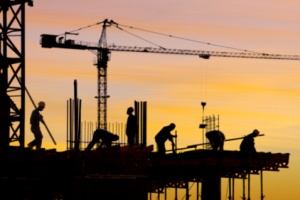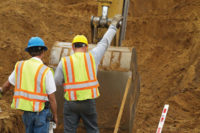 Controlling construction noise can pose special problems for contractors. Unlike general industry, construction activities are not always stationary and in one location.
Controlling construction noise can pose special problems for contractors. Unlike general industry, construction activities are not always stationary and in one location.
Construction activities often take place outside where they can be affected by weather, wind tunnels, topography, atmosphere and landscaping. Construction noise makers, e.g., heavy earth moving equipment, can move from location to location and is likely to vary considerably in its intensity throughout a work day
High noise levels on construction worksites can be lowered by using commonly accepted engineering and administrative controls. Laborers Health and Safety Fund of North America says normally, earplugs and other types of personal protective equipment (PPE) are used to control a worker’s exposure to noisy equipment and work areas. However, as a rule, engineering and administrative controls should always be the preferred method of reducing noise levels on worksites. Only, when these controls are proven unfeasible, earplugs as a permanent solution should be considered.
Engineering Controls
Engineering controls modify the equipment or the work area to make it quieter. Examples of engineering controls are: substituting existing equipment with quieter equipment; retro-fitting existing equipment with damping materials, mufflers, or enclosures; erecting barriers; and maintenance.
Administrative Controls
These are management decisions on work activities, work rotation and work load to reduce workers’ exposure to high noise levels. Typical management decisions that reduce worker exposures to noise are: moving workers away from the noise source; restricting access to areas; rotating workers performing noisy tasks; and shutting down noisy equipment when not needed.
Personal Protective Equipment
Earplugs are the typical PPE given to workers to reduce their exposure to noise. Earplugs are the control of last resort and should only be provided when other means of noise controls are infeasible. As a general rule, workers should be using earplugs whenever they are exposed to noise levels of 85 dB (A) or when they have to shout in order to communicate.
Construction sites can be quieter
Although many in the construction industry believe that construction sites are inherently noisy, there are many ways in which they can be made quieter.
• Sometimes a quieter process can be used. For example: Pile driving is very loud. Boring is a much quieter way to do the same work.
• New equipment is generally much quieter than old equipment. Some equipment manufacturers have gone to great lengths to make their equipment quieter. Ask equipment manufactures about the noise levels of their equipment and consider these levels when making your purchase. For example, noise-reducing saw blades can cut noise levels in half when cutting masonry blocks.
• Old equipment can be made quieter by simple modifications, such as adding new mufflers or sound absorbing materials.
• Old equipment is also much quieter when it is well maintained. Simple maintenance can reduce noise levels by as much as 50%.
• Noisy equipment can be sited as far away as possible from workers and residents. Noise levels drop quickly with distance from the source.
• Temporary barriers/enclosures (e.g. plywood with sound absorbing materials) can be built around noisy equipment. These barriers can significantly reduce noise levels and are relatively inexpensive.
•
Effective Practical Solutions to Controlling Noise on Construction Worksites
Every construction project is different and constantly changing. Therefore, noise control solutions have to be tailored for the situation. Fortunately, there are a variety of ways by which construction equipment and worksite noise can be controlled. The following is a list of ways to control noise level your worksites.
• Quieter Equipment
• Modifying Existing Old Equipment
• Barrier Protection
• Work Activity Scheduling
• Maintenance
• Noise Perimeter Zones
For more information, contact the Laborers Health and Safety Fund in Washington, D.C. at (202) 628-5465.



